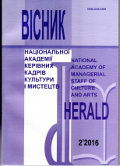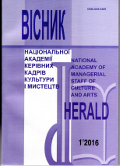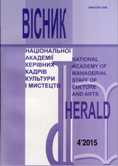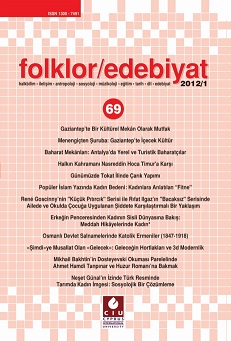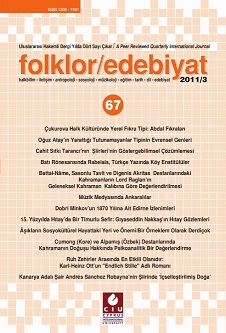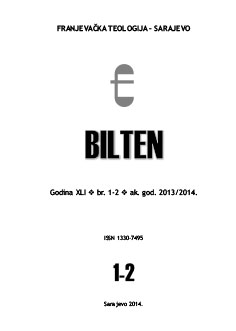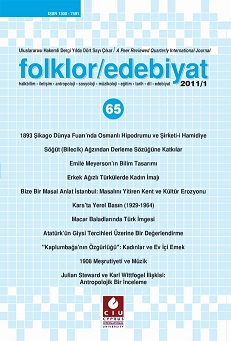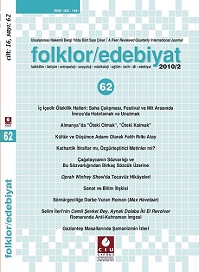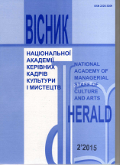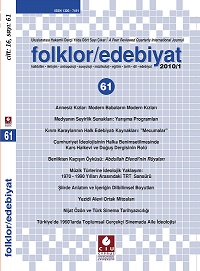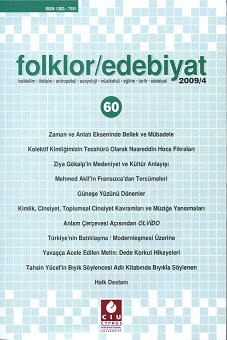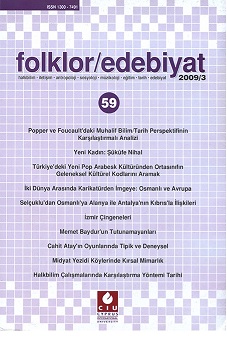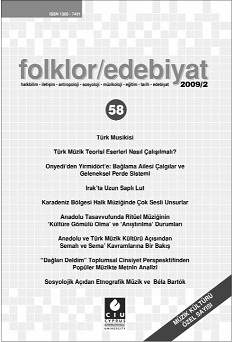Author(s): Natalia Tsiupa / Language(s): Ukrainian
Issue: 1/2016
The paper provides guidance on the preparation of folk style of singing. It is necessary to combine the knowledge of folklore, a high level of vocal performance, mastering the skills of acting, the ability to create a complete image, including using visual design. The urgent need is for a strong connection with the audience, which is achieved through active participation in the new cultural projects and initiatives.As noted, development of folk singing a manner in today’s conditions is quite important plays its popularization, which has taken away much attention. Despite the training, which figures prominently in the artistic and educational field and carried out at the appropriate level, attracting interest from the general public contribute to further advancement and sustainable interest from young people. Despite the lack of funding from the state, the number of projects aimed at the dissemination, popularization of folk art in general, and singing in folk style in particular. Within the large-scale festival "Country of Dreams", it has a long history of existence, quite a large part of the musical program given to folk music, and World music.The real wealth of every nation is its folklore. The problem of its preservation and functioning in modern society ap-pears difficult but essential task. Life folk music is inextricably linked to its performance, which leads to the need for education of singers who prefer "traditional style". The specificity of culture in modern society requires constant review requirements that apply to singers. In fact the presence of natural vocal abilities enough to succeed in professional activities. It is raised the task of forming a complex of characteristics by master performer. Their considerations will be devoted to this study. Although performing folk has repeatedly explained in scientific research, but with the development of artistic practice there are new aspects connected not only with perfect vocal performer, but also with its promotion through participation in various cultural projects. This aspect remains virtually disclosed in musicological thought. Some issues re-lated to the development of skills training folk singers analyzed in the works of such researchers as O.Kolomoyets, T. Kravtsov, V.Tormahova, A. Shishkin, S.Scherbinina.The article is to study the specifics of folk singing style of contemporary culture in Ukraine, providing formulation characteristics that should master performer. Among the groups that reproduce the style of folk singing, can identify several trends that are leading the organization of collective creativity:1) ensemble singing authentic folk songs; 2) teams that try to play not only the melody of folk songs, but also seek to create a complete performance, which represent part of the authentic rite; 3) Groups that use of folk songs musical material, but added more melodic, harmonic, rhythmic lines, even from other stylistic directions, resulting in a new cultural and artistic product. O.Shyshkina provides similar classification groups, under which the distinction made by the method of organization and form of existence repertoire features folk-singing groups. "The first one refers to the real original authentic folk-lore – it is the singers who are both carriers of folklore (they are doing it), the other folk groups, the repertoire dominated by folk-song works in the original or in the arrangement, and the third – a stylized groups, the foundation of which is handling the repertoire of folk sources, as well as works of authorship "[5, S.217]. According to the researcher, the last two lines of groups belonging to the phenomenon folklore repertoire is constantly expanding coverage through a variety of folk songs. There different approaches to the study of folklore. To achieve fame, contemporary folk performers singing manners should be actively promoted its activities through various cultural projects and their own individual uniqueness. The group "Tree" tends to perform songs in their authentic sound, completely without changing them, in relation to the material collected. "Bozic" although perform authentic songs, but they can also perform "wholesale improvisation" when sometimes combines elements of different variants of the same songs that involved other parts of songs. However, even taking part in projects with other groups, they are trying to preserve the identity and integrity of the songs, without mixing their own material on "neighboring". The team "Dakha Brakha" performs songs in arrangements that can be combined with the folklore of other countries cited, processed, mixed, moreover, usually served with instrumental accompaniment. An important aspect of the preparation of professional artist who chooses the style of folk singing, there is a problem repertoire and the singers own skills. We share the position O.A. Shyshkinoyi who notes that the folk songs re-quire a special approach that requires singers to become actors also able to convey the richness of folk songs. "The repertoire of folk singer should be associated closely with folklore. In this case it is impossible to use old tricks worked "academic" school. In singing folk artist is important not only has his vocal abilities, but also artistry, stage skills, danced mobility. In folk songs organically combines performance, music, word, game movement. It did not pass, relying only on his voice". There are certain criteria that should assess the level of people's singing performance, musical material, the skill of the singer, which includes not only the ability to play the melody, but also the ability to use typical singing timbre, right articulate, implement their own creative individuality, to perform work taking into account regional specifics voice, singers manner. It is also very important that the possession of "improvised methods of implementation (melodic, rhythmic, textural, harmonic variation, features polyphonic chant "the voice"); transcribing folk-song and author of works on stage (style costume, ethnographic or stylized, features dance, drama, concerts, stage decoration and general culture stage performers)". It should be noted that the training of national vocal associated with a number of requirements that apply to modern artist. They are stage skills, dances mobility. A contractor must be creatively active, take part in various cultural projects and be open to new initiatives. The high level of skills of the singers will promote popularization of Ukrainian folklore both in our country and abroad.
More...
